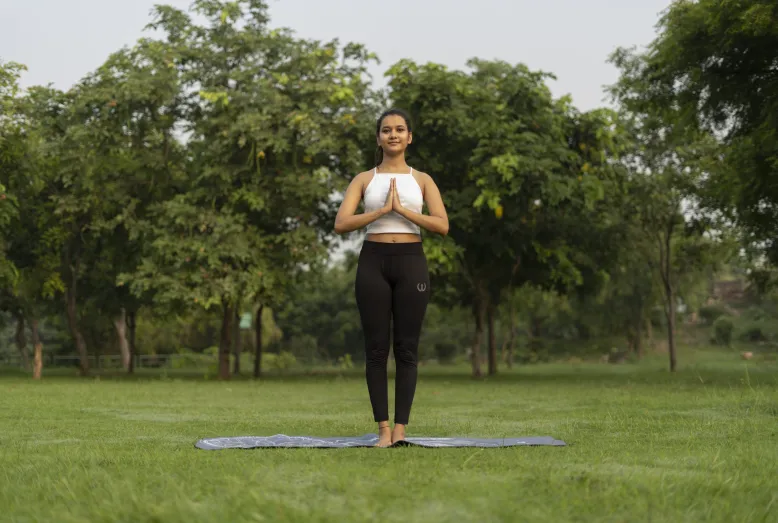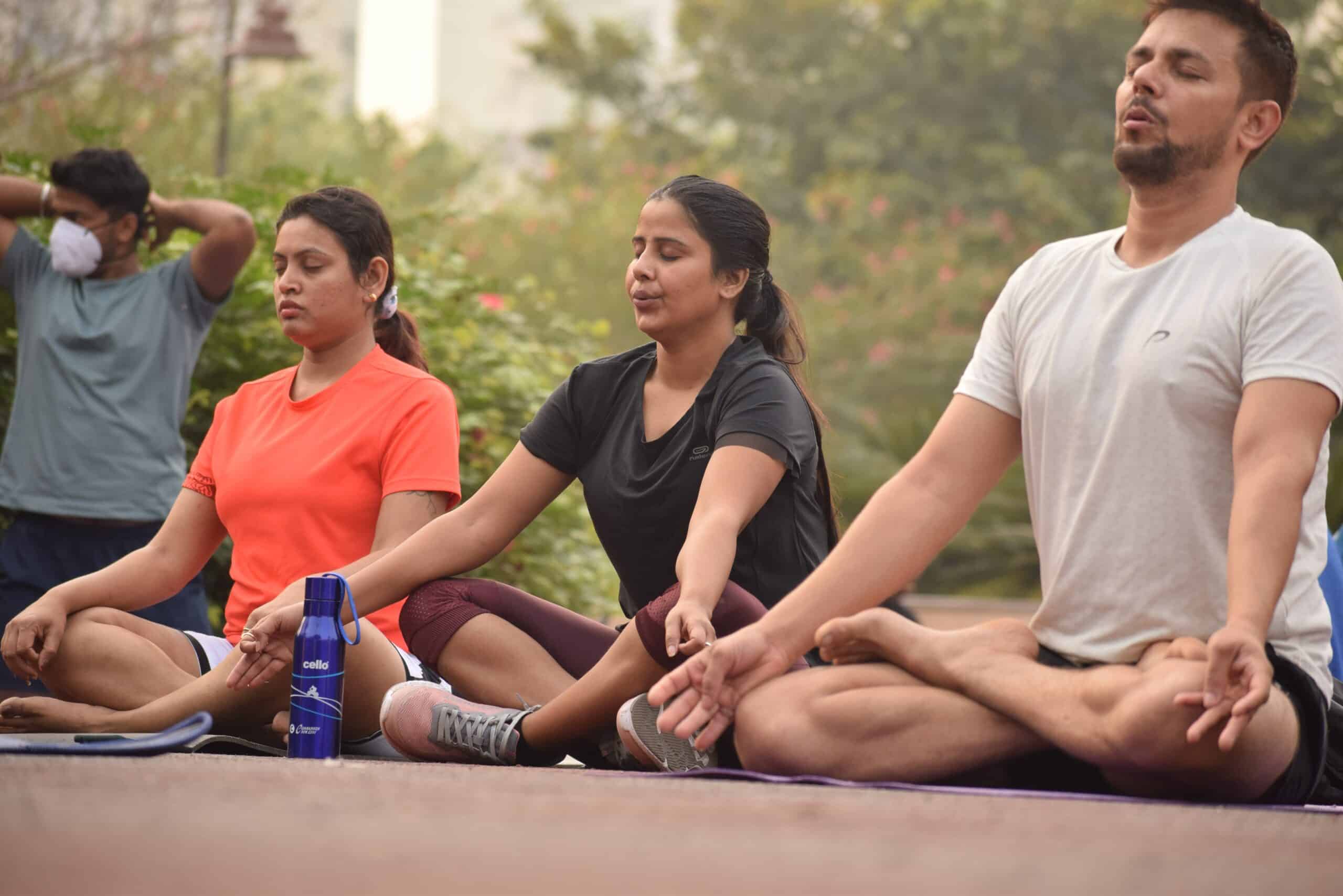In the broad expanse of yoga, there is a core pose that serves as a beacon of strength, stability, and internal alignment. Tadasana, also known as Mountain Pose, is the foundation for many other yoga postures.
Despite its apparent simplicity, this posture is profoundly meaningful, both physically and spiritually, providing practitioners with a path to self-awareness, balance, and composure. In this detailed examination, we will dig into the depths of Tadasana, uncovering its origins, mechanics, advantages, and transforming impact within yoga practice.
Table of Contents
Toggle### Origin and Symbolism
Tadasana, like many other yoga asanas, has profound origins in ancient Indian culture and philosophy. The phrase ‘Tadasana’ is derived from the Sanskrit words “tada,” meaning mountain, and “asana,” which imply position or seat. This etymology conjures up visions of a magnificent mountain standing tall and unshakable despite the ebb and flow of life.
In yogic philosophy, mountains represent stability, strength, and rootedness. It is a metaphor for each person’s unshakable core, signifying the intrinsic stability of the intellect and the enduring presence of the spirit in the face of adversity. By embracing the traits of a mountain in Tadasana, practitioners want to nurture these virtues within themselves, generating a feeling of strength and tenacity.
## The Physical Practice
Tadasana may seem deceptively easy at first glance since it simply entails standing motionless in an erect posture. However, attaining the position with optimal alignment and awareness is critical to maximizing its potential. Here’s a step-by-step tutorial for practicing Tadasana.
- Start by standing at the top of your mat, feet together or hip-width apart, whatever seems most comfortable and solid.
- Distribute your weight equally over the soles of your feet, grounding down at all four corners: the base of the big toe, the base of the little toe, and both sides of the heel. Lift the kneecaps slightly upward to use your leg muscles.
- **Lengthen your tailbone towards the floor while elevating the pubic bone toward the navel to engage the lower abdomen. This motion helps to balance the pelvis and provides a solid foundation.
- Draw the shoulder blades down the back to widen the collarbones and expand the chest. Relax your arms at your sides, palms facing inward or forward, and allow the fingers to curl inward softly. **
- Extend your spine upward, visualizing a cord gently dragging you toward the sky. Maintain neck alignment with the rest of the spine, avoiding thrusting forward or sinking back. To maintain balance and focus, gently gaze forward and select a focal point.
- Breathe deeply and evenly, keeping a sensation of rootedness in the feet while reaching up through the crown of the head. Feel the body realigning itself, finding a balance between power and ease. Hold the stance for a few breaths or until you feel comfortable.
## Benefits of Tadasana
While Tadasana seems to be a static pose, its advantages transcend well beyond the physical arena, embracing mental, emotional, and energy well-being. Some of the main benefits of practicing Tadasana are:
- Improves Posture: By aligning the body from head to toe, Tadasana corrects postural abnormalities and promotes good spinal alignment, lowering the risk of back discomfort and fostering a tall, dignified posture in everyday life.
- Enhances Balance and Stability: Balancing on two feet improves the muscles in the legs, ankles, and feet, increasing general stability and proprioception. This greater awareness of body posture may help older people avoid falls and injuries.
- Promotes Awareness and Mindfulness: Tadasana is a doorway to mindfulness, encouraging practitioners to focus on the present moment and develop awareness of physiological sensations, breath, and mental fluctuations. Individuals who practice regularly acquire a stronger connection to themselves and their environment, which promotes inner calm and clarity.
- It energizes the body. Despite its apparent calmness, Tadasana is a dynamic position that activates and energizes the whole body. Practitioners establish a conduit for unfettered energy flow by anchoring down via the feet and rising upward through the head, renewing the body and mind.
- Calms the Mind: Tadasana’s calm and simplicity create a mental retreat amid everyday bustle. Practitioners achieve a feeling of serenity and equanimity by focusing their attention on the present moment and the physical sensations of their bodies, therefore lowering tension and anxiety levels.
Learn More: Benefits of Tadasana
## Variations and Modifications
While the fundamental alignment principles of Tadasana remain constant, several variants and adaptations may accommodate particular requirements and abilities:
1. **feet hip-width apart:** For individuals who lack balance or stability, expanding the stance to hip-width apart might give a more stable base, making it simpler to maintain the posture.
2) Chair Tadasana: Tadasana using a chair might be useful for those who have mobility challenges or injuries. Simply stand with the backs of your legs softly leaning on the chair, utilizing it for support as required while maintaining proper alignment and extension.
3. **Wall Tadasana.** Standing with one’s back against a wall may help people build a feeling of alignment and awareness while also offering feedback on posture and spinal position. Pressing softly against the wall with the back of the head, shoulder blades, and hips helps promote a straighter, more extended spine.
4. **Arm Variations:** Experiment with various arm positions to see how they affect the shoulders, chest, and breathing. Options include extending the arms upwards with palms touching or clasped together, raising the hands to a prayer posture at the heart center, or grasping opposing elbows behind the back.
5. Visualization: Incorporate visualization methods to enhance the Tadasana experience. Imagine roots stretching from the soles of your feet into the soil, anchoring you securely like a tree. Consider yourself a mountain, standing strong and uncompromising in the middle of life’s ever-changing terrain.
### Incorporating Tadasana into Your Practice
Tadasana is a wonderful starting place for any yoga practice, giving a firm foundation for developing strength, flexibility, and awareness. Here are some methods to include Tadasana in your routine:
1. The Morning Ritual: Begin your day with a few minutes of Tadasana yoga to set the tone for a grounded and focused day. Concentrate on aligning the body, connecting with the breath, and establishing a feeling of presence and purpose for the day ahead.
2) **Warm-up Sequence:** Use Tadasana as the foundation for a more dynamic warm-up sequence, progressing through soft stretches and flowing motions to awaken the body and prepare it for deeper asana practice.
3. **Posture Correction** If you spend a long time sitting or standing in a slouched posture, take frequent pauses to practice Tadasana and correct your body. Use this chance to counteract the consequences of bad posture and relieve muscular strain.





No Comments